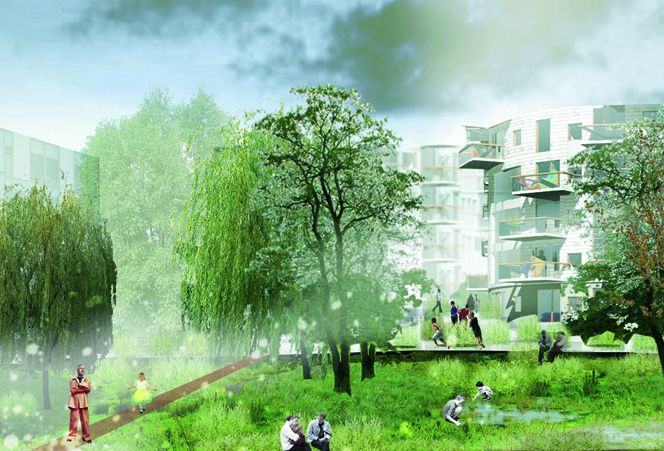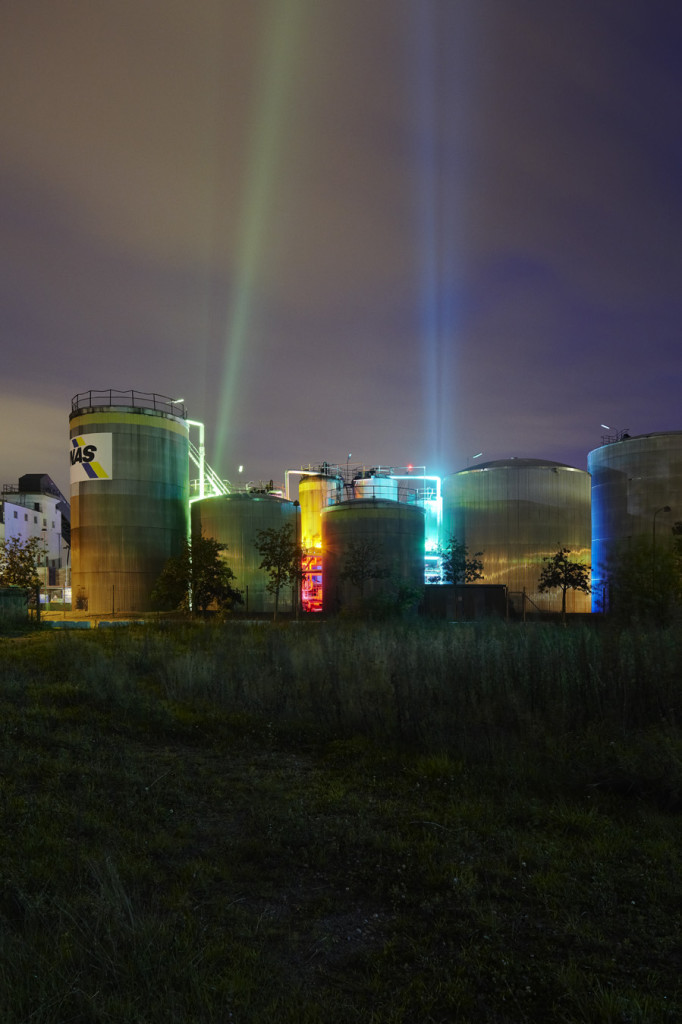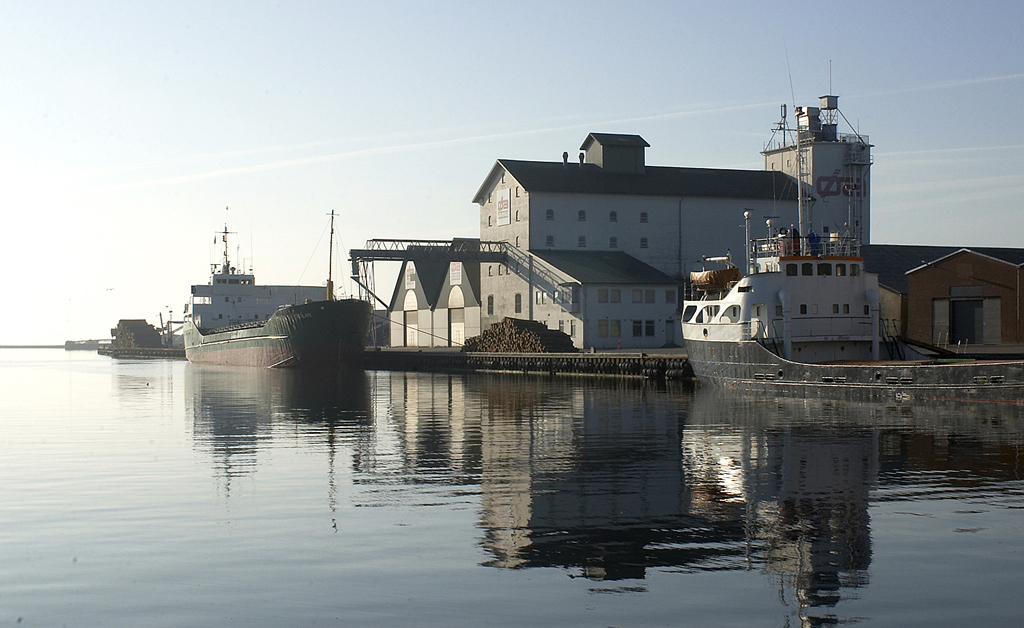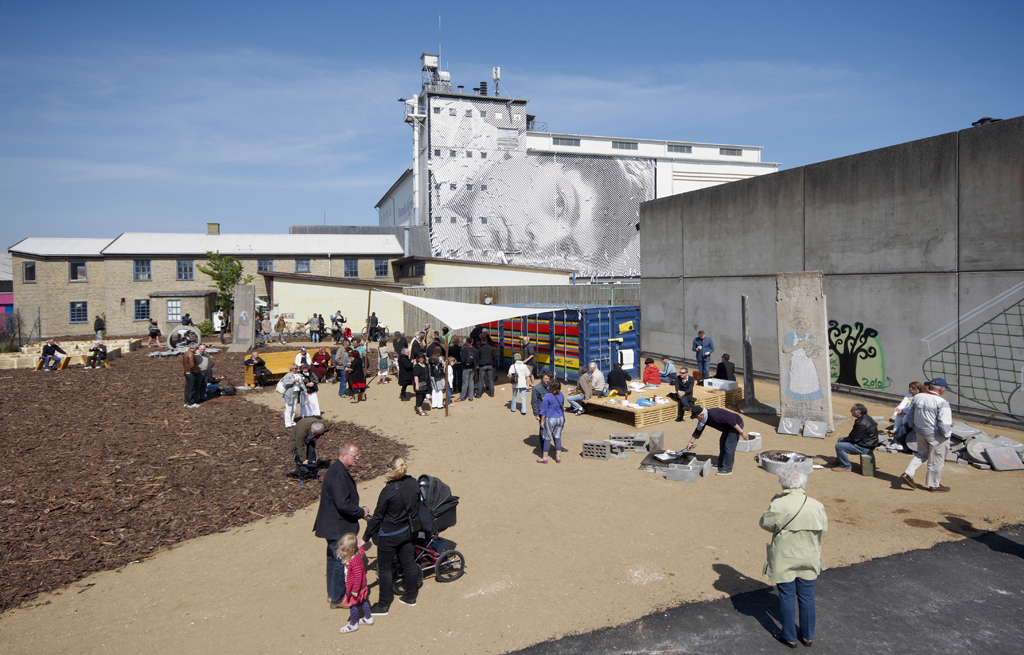Køge is one of the medium-sized Danish towns having seized the historic chance: transforming centrally located harbour and industrial areas into a modern and sustainable urban district. For a town of 35,000 inhabitants, perspectives go beyond the mere changing of near-harbour areas. It may change the entire town.
In 2009, Realdania By formed a partnership with the Municipality of Køge with the clear intention of seizing this historic chance. Together, we are responsible for the Køge Kyst urban development project, which will develop three centrally located areas, the Station Area, the South Harbour and the Collstrop Site, into an urban district characterised by quality in urban development and interaction with the historical town centre and which is sustainable in environmental, social, health and economic terms.
 The future commons in Køge Kyst include green and blue elements that encourage a variety of social and physical interactions, hereby supporting the overall sustainable strategy.
The future commons in Køge Kyst include green and blue elements that encourage a variety of social and physical interactions, hereby supporting the overall sustainable strategy.
The project will turn the town to face the sea and make the entire town more coherent. Another factor adding to the need for coherence is the railway cutting through Køge, a barrier in the town for many years.
The Municipality of Køge had been far-sighted enough to incorporate harbour jobs and industries in a sustainable urban development strategy. In step with the urban development in Køge Kyst, the industrial enterprises still located in the area will move to a new, and larger, modern industrial harbour, which is being developed north of the town centre.
Vision is realised step by step
Køge Kyst will not build the future development projects itself. The partnership has invested in the areas and will develop them and finally sell them in stages to investors, who will build the new development projects.
The investors are met by quality targets to ensure the realisation of our common vision: to create a unique, attractive and sustainable urban district strengthening the role of Køge as a centre in the metropolitan area, Zealand and the total Øresund region. The vision focuses on these six vision points:
- Culture as a driving force in urban development
- Retail trade to highlight Køge as an attractive commercial town
- Infrastructure to become an asset for the town
- Urban development, renewal and construction to be distinguished by creativity and high quality
- Citizens and other stakeholders to participate actively in urban development
- Sustainability is the overriding principle for urban development and renewal
During the next 20 years or so, the vision will be realised step by step. Even before the first buildings have been erected, the project has given priority to an ongoing dialogue with citizens and stakeholders, including in the competition process and when the project development plan was subsequently prepared. Also, by virtue of many large and small events, culture has already taken hold as a driving force in the sense of creating attention to and life and ownership in the new urban district already before the first construction.
First investor agreement
In February 2012, Køge Kyst concluded a conditional purchase agreement with the first investor in the project, who will erect an ambitious project in the Station Area. Besides housing and offices, it will include a much-needed expansion of Køge’s existing retail trade – in close interaction with existing shops in the town centre.
With the new building project, the realisation of three other vision points will move close, i.e. making retail trade an asset for the town, strengthening the town’s infrastructure with new connections across the railway, which Køge Kyst must establish simultaneously with the new building project. Finally, the first building project will demonstrate high-quality architecture, interacting with Køge’s historical and very special town centre with its many, small, well-preserved yellow and red houses.
Flexible development plan
How will the vision be realised? Køge Kyst’s 2011 development plan provides the preliminary answer. It consists of a physical plan and strategies for sustainability, culture and urban life, industrial development, traffic and parking – and dialogue.
The development plan does not determine urban development in all details, but is flexible and dynamic, so it can cater for the changing needs and trends of coming decades – and the urban life that will arise on the way. Flexibility is a response to the classical master plan – in recognition that we cannot be so clever as to predict what will be the perfect layout of the town in 20 years! We allow ourselves to learn as we go along.
The international competition, on which the development plan is based, was also characterised by a learning approach – and interdisciplinarity was a requirement to the international teams, which combined strong competencies in fields such as architecture, infrastructure, economy, urban life and sustainability. Because we do not believe that one professional group have the answers to the great challenges in such a complex and ambitious project – and creative ideas often arise in the meeting between different ways of thinking.
Just as important as innovative thinking is embeddedness in the location. Hence, the development plan is based on Køge being an old industrial harbour town with a well-preserved historical town centre, a strong position as a junction close to the capital and fine prospects for the future, stressed by recent years’ political decisions to establish a new railway line via Køge and place a super hospital in the town.
Several roads to a living and sustainable town
The strategy to create life before buildings finds expression in the strong commitment to culture, which has put Køge on the cultural map of Denmark with well-attended outdoor art exhibitions, a new jazz festival and many other activities that create ownership among town citizens.
A good mixture of housing, shops and industry also helps to create life and dynamism. The Køge Kyst partnership believes that such mixture of functions, combined with social diversity, where children, young people, adults and old people from different walks of life can live closely together, is a primary condition for the excellent town.
Health sustainability is also a key factor, and the development plan attaches importance to creating urban spaces that invite citizens to stay there, take part in activities and play for as long as possible.
The town is tied together
Culture also plays a part in the efforts to tie the town together and break the barrier of the railway. In 2011, Køge Kyst inaugurated “the Thread” as a new cultural connection between the town centre and the sea. Here, new, temporary urban spaces and activities are being tested, and activity spaces, art, lighting installations and information about the past, present and future of the place are found along the route.
Physically, the new and old town will be tied together by four new connections across the railway, including a new, wide underpass, which will also work as a centrally-situated new urban space – a “hinge” between the urban districts.
 After dark the lighting installations highlight elements along “the Thread” in Køge. The poetic settings help create awareness of the qualities of the city and the harbour – as well as the relationship between the new and the old town.
After dark the lighting installations highlight elements along “the Thread” in Køge. The poetic settings help create awareness of the qualities of the city and the harbour – as well as the relationship between the new and the old town.
Commons – a green and blue structure in the town
Streams, grass, trees and other blue and green elements will underpin sustainability and create diversity and experiences. In the South Harbour, a number of commons will be the green and blue main district structure, offering ample opportunities for experiencing nature in the town. Varied planting and visible rainwater will be main elements, and, with a few, unavoidable exceptions, pedestrians and cyclists will be the only traffic.
The commons are sustainable in both health and environmental terms and form part of a general solution to climate adaptation that can counter future water-level rises and flooding – a challenge applying to all harbour towns.
The modern town in the South Harbour will end with a town frontage and a promenade facing a beach meadow, whose wild nature will be allowed to move into the town itself through some of the commons. The beach area is to be used for different kinds of recreation including water sports, walking and running and will help create life and quality of life in the area – all year round.
 Together, the future town frontage and promenade in the South Harbour will form a transition to the wild nature of the beach meadow.
Together, the future town frontage and promenade in the South Harbour will form a transition to the wild nature of the beach meadow.
The partnership – a strong model
All these projects could hardly be implemented without a partnership structure like the present one, with the project management being firmly rooted in the local political system and local processes, while Realdania By contributes broad knowledge of and competence in urban development.
Together, we practice active ownership – in the daily work through the joint partnership, which also carries the name Køge Kyst – and while the long road forward is flexible and movable, the vision is firmly established!
FACT BOX
The Station Area will include a significant expansion of the town’s present retail trade and create an eventful connection to Køge’s historical town centre. Moreover, the area will house offices and a small number of residential properties.
The South Harbour will be developed with housing and cultural and office facilities. The architecture will be inspired by the qualities already existing in the harbour, on the quays and on the beach close by. The South Harbour will invite citizens to use the area culturally and recreationally – also on the new beach island.
 Today the South Harbour in Køge houses a variety of industries related to the port and to sea carriage. Over the next 10-20 years these industries will move to a harbour area further north.
Today the South Harbour in Køge houses a variety of industries related to the port and to sea carriage. Over the next 10-20 years these industries will move to a harbour area further north.
The Collstrop Site will house a modern, dynamic and sustainable commercial environment.
Additional information is available at uk.koegekyst.dk.
 As a part of the strategy to create life before buildings Køge Kyst is transforming South Harbour – areas into temporary spaces for cultural life and activities.
As a part of the strategy to create life before buildings Køge Kyst is transforming South Harbour – areas into temporary spaces for cultural life and activities.
FACT BOX – REALDANIA BY
Realdania By aims at creating visionary and sustainable urban development, centring on human quality of life. The company works through philanthropic investments in partnership projects on urban development such as Køge Kyst, FredericiaC and Ringkøbing K. Realdania By also offers knowledge about and inspiration for visionary urban development to other professionals.